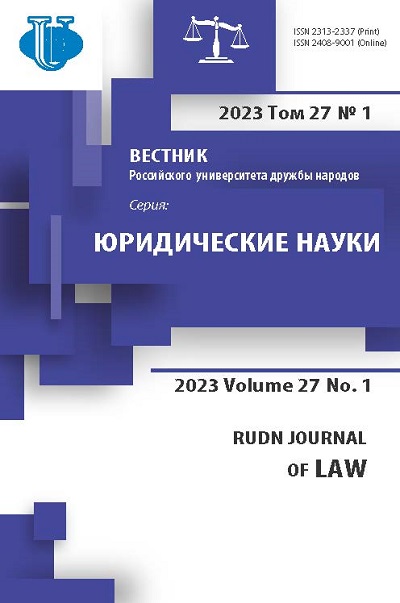Forms of implementation of corporate rights of the members of commercial corporations: history, current contradictions and development prospects
- Authors: Samoilov I.A.1
-
Affiliations:
- Russian Presidential Academy of National Economy and Public Administration (RANEPA)
- Issue: Vol 27, No 1 (2023)
- Pages: 166-180
- Section: CIVIL LAW
- URL: https://journals.rudn.ru/law/article/view/34063
- DOI: https://doi.org/10.22363/2313-2337-2023-27-1-166-180
- ID: 34063
Cite item
Full Text
Abstract
The purpose of the study is to identify problems arising from the discrepancy between the norms of the current corporate legislation, whose basic principles were laid down during the development of the industrial type of economic development, and the current stage, characterized by the active development of the post-industrial type of economy. The subject of the study is the forms of realization of the corporate rights of members in commercial corporations, and, above all, business entities. The research employs the following scientific methods of analysis: historical analysis of the influence of economic development factors (types of activity, scale of activity, significant resources) on the forms of exercising corporate rights of corporation members and analysis of correspondence of modern forms of realization of corporate rights to the system of interests of the members of post-industrial types of corporations at the modern stage of economic development. The research results. In the traditional economy of the industrial type, the main significant resource is non-current tangible and current assets. Today their cost estimate determines the volume of corporate rights. In the post-industrial economy, non-current intangible assets become the main significant resource; their evaluation seems to be problematic in a significant number of cases. The research reveals the problems of inconsistency of modern forms of realization of corporate rights of members in the post-industrial corporations with the system of interests of members - carriers of a creative resource (ideas, professional knowledge, etc.) - in such corporations. Practical implementation of the research outcome is realized in suggestions and recommendations that can be applied both in the field of improving corporate legislation and legal support of commercial corporations’ activities. Among other things, a forecast of trends in the development of corporate legislation in terms of implementation of corporate rights has been worked out.
About the authors
Ilya A. Samoilov
Russian Presidential Academy of National Economy and Public Administration (RANEPA)
Author for correspondence.
Email: samil@rambler.ru
ORCID iD: 0000-0002-5318-4419
Candidate of Economic Sciences, Associate Professor of the Department of Entrepreneurial, Corporate and Labor Law, Faculty of Law. Speransky Institute of Law and National Security
84, bldg. 3, Prospekt Vernadskogo, Moscow, 119571, Russian FederationReferences
- Bell, D. (1999) The Coming of Post-industrial Society: A Venture in Social Forecasting. New York, Basic Books.
- Berle, A.A. & Means, G.C. (1933) The Modern Corporation and Private Property. New York, The Macmillan Company.
- Clarkson, K. & Miller, R. (2019) Business Law: Text and Cases. South-Western College Publishing.
- Gabov, A.V., Gubin, E.P. & Karelina, S.A., et al. (2019) Corporate law: textbook. Moscow, Statut Publ. (in Russian).
- Drucker, P.F. (1993) Post-capitalist Society. Oxford, Butterworth Heinemann.
- Galbraith, J.K. (1985) The New Industrial Society. Boston, Houghton Mifflin.
- Inozemtsev, V.L. (2000) Modern post-industrial society: nature, contradictions, prospects. Moscow, Logos Publ. (in Russian).
- Hage, J. & Powers, Ch.H. (1992) Post-Industrial lives: Roles and relationships in the 21st century. Newbury Park, Calif., Sage Publications.
- Kapoor, N.D. (2015) Elements of Company Law. Sultan Chand & Sons-New Delhi.
- Kraakman, R.H., Davies, P. & Hansmann, H. et al. (eds.). (2004) The Anatomy Of Corporate Law: A Comparative And Functional Approach. Oxford University Press.
- Krylov, V.G. (2018) Prospects for the development of a corporate agreement in Russia. Civil Law. (6), 14-17. https://doi.org/10.18572/2070-2140-2018-6-14-17 (in Russian).
- Lomakin, D.V. (2018) Corporate rights of business entity participants: relevant issues and statutory regulation prospects. Entrepreneurial Law - Application. (2), 28-34. (in Russian).
- Mogilevskiy, S.D. & Samoilov, I.A. (2007) Corporations in Russia: Legal status and basics of activity. Moscow, Delo Publ. (in Russian).
- Mogilevskiy, S.D. & Egorova, M.A. (2015) Corporate protection as a reflection of the essence of corporate rights. Civil Law. (1), 3-6. (in Russian).
- Mogilevskiy, S.D. (2010) Limited Liability Company: Legislation and practice of its application. Moscow, Statute Publ. (in Russian).
- Oranburg, S.C. (2019) Oranburg’s Corporate Law Compendium: Shareholder Rights. Independently Published.
- Romano, R. & Winter, R.K. (1993) The Genius of American Corporate Law. American Enterprise Institute Press.
- Samoilov, I.A. (2022a) Problems of implementation of corporate rights of shareholders in shareholding companies in innovative projects. Juridical World. (4), 40-43. https://doi.org/10.18572/1811-1475-2022-4-40-43 (in Russian).
- Samoilov, I.A. (2022 b) The “power of capital” and “the power of contract” in commercial corporations in a “creative” economy. Civil Law. (1), 24-29. https://doi.org/10.18572/2070-2140-2022-1-24-29 (in Russian)
- Toffler, A. (1980) The Third Wave. New York, Morrow.
- Vaypan, V.A., Gabov, A.V. & Gubin, E.P., et al. (2021) Scientific and Practical Commentary on the Federal Law on Limited Liability Companies: in 2 vols. Vol. 1. Shitkina I.S. (ed.). Moscow, Statute Publ. (in Russian).
Supplementary files















